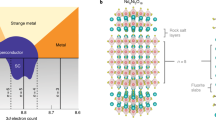Abstract
The interplay of magnetic interactions, the dimensionality of the crystal structure and electronic correlations in producing superconductivity is one of the dominant themes in the study of the electronic properties of complex materials. Although magnetic interactions and two-dimensional structures were long thought to be detrimental to the formation of a superconducting state, they are actually common features of both the high transition-temperature (Tc) copper oxides and low-Tc material Sr2RuO4, where they appear to be essential contributors to the exotic electronic states of these materials1. Here we report that the perovskite-structured compound MgCNi3 is superconducting with a critical temperature of 8 K. This material is the three-dimensional analogue of the LnNi2B2C family of superconductors, which have critical temperatures up to 16 K (ref. 2). The itinerant electrons in both families of materials arise from the partial filling of the nickel d-states, which generally leads to ferromagnetism as is the case in metallic Ni. The high relative proportion of Ni in MgCNi3 suggests that magnetic interactions are important, and the lower Tc of this three-dimensional compound—when compared to the LnNi2B2C family—contrasts with conventional ideas regarding the origins of superconductivity.




Similar content being viewed by others
References
Rice, T. M. Unconventional superconductors: contrasting cuprates and ruthenates. Physica C 341–348, 41–46 (2000).
Cava, R. J. et al. Superconductivity in the quaternary intermetallic compounds LnNi2B2C. Nature 367, 252–253 (1994).
Scheil, E. & Huetter, L. Zur Kennetis des Systems Nickel-Kohlenstoff-Magnesium. Z. Metallk. 44, 387–389 (1953).
Huetter, L. J. & Stadelmaier, H. H. Ternary carbides of transition metals with aluminum and magnesium. Acta Metall. 6, 367–370 (1958).
Nohara, M., Isshiki, M., Takagi, H. & Cava, R. J. Magnetic field dependence of the low-temperature specific heat of the borocarbide superconductor, LuNi2B2C. J. Phys. Soc. Jpn 66, 1888–1891 (1997).
Kresin, V. Z. & Parchomenko, V. Thermodynamic properties of strong-coupling superconductors. Sov. Phys. Solid State 16, 2180–2184 (1975).
Kresin, V. Z. On the critical temperature for any strength of the electron–phonon coupling. Phys. Lett. A 122, 434–438 (1987).
Chamberland, B. L. in Chemistry of Superconducting Materials 2–104 (ed. Vanderah, T. A.) Noyes, Park Ridge, NJ, 1992).
Acknowledgements
This research was supported by grants from the US National Science Foundation and the US Department of Energy.
Author information
Authors and Affiliations
Corresponding author
Rights and permissions
About this article
Cite this article
He, T., Huang, Q., Ramirez, A. et al. Superconductivity in the non-oxide perovskite MgCNi3. Nature 411, 54–56 (2001). https://doi.org/10.1038/35075014
Received:
Accepted:
Issue Date:
DOI: https://doi.org/10.1038/35075014
- Springer Nature Limited
This article is cited by
-
Room Temperature Ferromagnetic Behavior of Nanocrystalline LaFeO3 Perovskite Oxide Synthesized Through Phytochemical Mediated Combustion Technique
Journal of Cluster Science (2024)
-
Electronic and Mechanical Properties of High-Spin-Polarized Perovskite Compounds Cs2XYF6 (X = K, Ti and Tl, Y=Fe and V)
Journal of Superconductivity and Novel Magnetism (2024)
-
Perovskite synthesizability using graph neural networks
npj Computational Materials (2022)
-
Superconductivity in antiperovskites
npj Computational Materials (2022)
-
Tuning band gap and enhancing optical functions of AGeF3 (A = K, Rb) under pressure for improved optoelectronic applications
Scientific Reports (2022)





